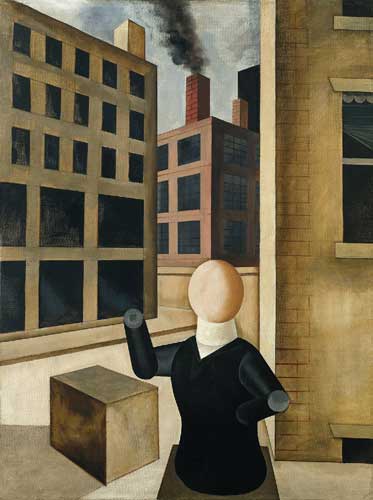Great Works: Untitled, Or Figure In Front Of City Buildings (1920), George Grosz
Kunstsammlung Nordrhein-Westfalen, Dusseldorf

A great reduction: that's one of the effects of early modern art. The world is redesigned, planed and simplified and geometricated, as if it were the product of the most streamlined manufacture. For example, there's George Grosz's Figure in Front of City Buildings.
He's a surprising artist to find doing it. Grosz is famous for his excoriating caricature. But inspired by the doll-like characters and dollhouse architecture of the Italian Giorgio de Chirico, Grosz's forms are briefly purified. Almost everything here is composed of smooth regular solids – ovoid and cuboid, truncated cone and cylinder.
The human figure is transformed into a perfect egg-headed creature. Its arms are lopped tubes, handless, with a broken join for the elbow. Only its torso has a hint of organic shaping, in the curves of its bust and waist, suggesting a dressmaker's mannequin (and that its sex is female). Its hips are sat on a square skirt.
The rules of reduction are not quite consistent. The buildings are mainly plain boxes with blank windows, but some fine detailing does intrude – notice the blind in the face-on window glimpsed at right front. And this hard-edged world is once interrupted by something blurry, the column of belching black smoke.
As for the isolated cube sitting in the middle of the road, what might it be? If something as complex as a head can simplified down an ovoid, then the cube could be almost any medium-sized object, likewise simplified. Without the clues that allow us to read the ovoid as a head this cube remains unidentifiable.
But the picture holds a larger puzzle: its meaning. Does this simplified vision show an idealised world, or a satirised one? Perhaps it's a modern utopia, where the individual is transcended into impersonal, egalitarian, collective life. Perhaps it's a dystopia, where the individual is stunted into standardised, robotic conformity. Compare this image with two similar Grosz pictures from the same date. They both have egg-headed, tube-limbed figures, and a street of box buildings. But their clues are ambiguous. The Cyclist shows a couple of these anonymous figures, riding a bicycle and lifting weights – sporty, working-class heroes. But in Republican Automatons the figures wear a bowler hat and an Iron Cross – mindless, bourgeois-militarist villains. The same visual language carries opposite values.
There are other possible sentiments. Contemporary images by Grosz and Otto Dix show the war-wounded, with prosthetic limbs crudely stuck onto them. They emphasise the mix-up of flesh with mechanical elements. Perhaps that feeling – horrible, painful, grotesque – is faintly present here.
Or perhaps there's a more anarchic comedy, a delight in the body as something mechanical and involuntary, as in the early paintings of Chirico or Marcel Duchamp. The human being is shown up, despite its high pretentions, as what it really is – a gadget-puppet. It's happily liberated from the troubles of consciousness into the joys of automatism.
All possibilities. But among those diverse moral gears, Figure in Front of City Buildings keeps in neutral. And it may be that sheer beauty is the only design it has upon us.
About the artist
George Grosz (1893-1959) was a rare case of a great crossover – like Daumier and Lautrec, both illustrator and artist. He anglicised his name during the First World War, as an anti-patriotic gesture. He drew savage caricatures of Berlin society, scenes of sex, greed and violence, in his cutting ink-line. He joined the artistic avant-garde, with sharp collage and furious apocalyptic paintings. He was a big lefty. But his years of genius were brief: over by the early Twenties. His later work, in Germany, and then in America in exile from Hitler, gets sloppier.
Join our commenting forum
Join thought-provoking conversations, follow other Independent readers and see their replies
Comments
Bookmark popover
Removed from bookmarks